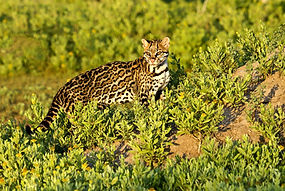
Habitat Loss
The land along the Brownsville Ship Channel is a critical wildlife corridor that links Lower Rio Grande Valley National Wildlife Refuge tracts near Boca Chica with the Laguna Atascosa National Wildlife Refuge north of the channel. Pipelines and compressor stations will be located outside of the Port in critical wildlife habitat areas. The Rio Bravo Pipeline, the Valley Crossing Pipeline, and its compressor station will be located west of the Laguna Atascosa Wildlife Refuge. On the left map, this area is colored pink and is a focus area for wildlife migration. Even though it is not official National Wildlife Refuge land, it is recognized as a critical area for wildlife migration and biological diversity.

The coastal habitat along the lower ship channel allows endangered ocelots to travel between the two refuges. Losing the connecting habitat will make this trip impossible and may doom the ocelot in Texas. Other threatened and endangered wildlife that will be put at risk include the Aplomado falcon and the Piping plover.
photo credit: Larry Ditto

The projects will also require the destruction of mangrove habitat and filling in wetlands. Wetlands are protected under the Clean Water Act because they are important nurseries for aquatic life, they act as water filtration systems, and they prevent the erosion of our coastlines.

photo credit: Seth Patterson
The LNG leases are immediately adjacent to the Bahia Grande, site of the largest wetlands restoration project in North America. This bay and wetland area could be damaged by the toxic emissions and runoff from the LNG projects. Wildlife will be disrupted by the noise, lights and activities of LNG production. The projects will also almost certainly end the recreational fishing, boating, and birding that take place at the boat ramp, restoration channel and in the bay.
The LNG plans also entail massive amounts of dredging, both in the ship channel itself and, for several of the companies, the creation of new turning basins. Dredging disturbs marine life and can stir up toxic sedimentary contaminants. The dumping of the spoils destroys the wetland and upland habitats where it is dumped.








